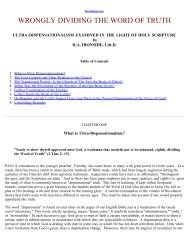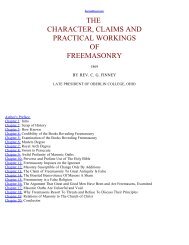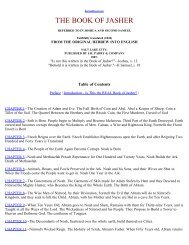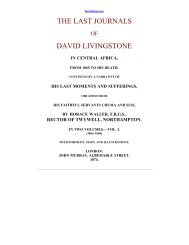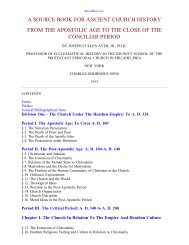Legends of Babylon and Egypt in Relation to Hebrew Tradition.pdf
Legends of Babylon and Egypt in Relation to Hebrew Tradition.pdf
Legends of Babylon and Egypt in Relation to Hebrew Tradition.pdf
You also want an ePaper? Increase the reach of your titles
YUMPU automatically turns print PDFs into web optimized ePapers that Google loves.
<strong>and</strong> up-stream <strong>of</strong> "Nimrod's Dam". The Tharthâr escape would dra<strong>in</strong> <strong>in</strong><strong>to</strong> the Euphrates, <strong>and</strong> the latter's Habbânîyah<br />
escape would receive any surplus water from the Tigris, a second barrage be<strong>in</strong>g thrown across the Euphrates upstream<br />
<strong>of</strong> Fallûjah, where there is an outcrop <strong>of</strong> limes<strong>to</strong>ne near the head <strong>of</strong> the Sakhlawîyah Canal. The Tharthâr<br />
depression, besides dispos<strong>in</strong>g <strong>of</strong> the Tigris flood-water, would thus probably feed the Euphrates; <strong>and</strong> a second barrage<br />
on the Tigris, <strong>to</strong> be built at Kût, would supply water <strong>to</strong> the Shatt el-Hai. When the country is freed from danger <strong>of</strong><br />
flood, the Baghdad Railway could be run through the cultivated l<strong>and</strong> <strong>in</strong>stead <strong>of</strong> through the eastern desert; see<br />
Willcocks, /The Near East/, Oct. 6, 1916 (Vol. XI, No. 283), p. 545 f.<br />
[2] It was then that Sir William Willcocks designed the new H<strong>in</strong>dîyah Barrage, which was completed <strong>in</strong> 1913. The<br />
H<strong>in</strong>dîyah branch, <strong>to</strong>-day the ma<strong>in</strong> stream <strong>of</strong> the Euphrates, is the old low-ly<strong>in</strong>g Pallacopas Canal, which branched<br />
westward above <strong>Babylon</strong> <strong>and</strong> discharged its waters <strong>in</strong><strong>to</strong> the western marshes. In antiquity the head <strong>of</strong> this branch had<br />
<strong>to</strong> be opened <strong>in</strong> high floods <strong>and</strong> then closed aga<strong>in</strong> immediately after the flood <strong>to</strong> keep the ma<strong>in</strong> stream full past<br />
<strong>Babylon</strong>, which entailed the employment <strong>of</strong> an enormous number <strong>of</strong> men. Alex<strong>and</strong>er the Great's first work <strong>in</strong><br />
<strong>Babylon</strong>ia was cutt<strong>in</strong>g a new head for the Pallacopas <strong>in</strong> solid ground, for hither<strong>to</strong> it had been <strong>in</strong> s<strong>and</strong>y soil; <strong>and</strong> it was<br />
while reclaim<strong>in</strong>g the marshes farther down-stream that he contracted the fever that killed him.<br />
From this brief sketch <strong>of</strong> progressive disaster dur<strong>in</strong>g the later his<strong>to</strong>rical period, the <strong>in</strong>evitable effect <strong>of</strong> neglected silt<br />
<strong>and</strong> flood, it will be gathered that the two great rivers <strong>of</strong> Mesopotamia present a very strong contrast <strong>to</strong> the Nile. For<br />
dur<strong>in</strong>g the same period <strong>of</strong> misgovernment <strong>and</strong> neglect <strong>in</strong> <strong>Egypt</strong> the Nile did not turn its valley <strong>and</strong> delta <strong>in</strong><strong>to</strong> a desert.<br />
On the Tigris <strong>and</strong> Euphrates, dur<strong>in</strong>g ages when the earliest dwellers on their banks were struggl<strong>in</strong>g <strong>to</strong> make effective<br />
their first efforts at control, the waters must <strong>of</strong>ten have rega<strong>in</strong>ed the upper h<strong>and</strong>. Under such conditions the s<strong>to</strong>ry <strong>of</strong> a<br />
great flood <strong>in</strong> the past would not be likely <strong>to</strong> die out <strong>in</strong> the future; the tradition would tend <strong>to</strong> gather illustrative detail<br />
suggested by later experience. Our new text reveals the Deluge tradition <strong>in</strong> Mesopotamia at an early stage <strong>of</strong> its<br />
development, <strong>and</strong> <strong>in</strong>cidentally shows us that there is no need <strong>to</strong> postulate for its orig<strong>in</strong> any convulsion <strong>of</strong> nature or<br />
even a series <strong>of</strong> seismic shocks accompanied by cyclone <strong>in</strong> the Persian Gulf.<br />
If this had been the only version <strong>of</strong> the s<strong>to</strong>ry that had come down <strong>to</strong> us, we should hardly have regarded it as a record<br />
<strong>of</strong> world-wide catastrophe. It is true the gods' <strong>in</strong>tention is <strong>to</strong> destroy mank<strong>in</strong>d, but the scene throughout is laid <strong>in</strong><br />
Southern <strong>Babylon</strong>ia. After seven days' s<strong>to</strong>rm, the Sun comes out, <strong>and</strong> the vessel with the pious priest-k<strong>in</strong>g <strong>and</strong> his<br />
domestic animals on board grounds, apparently still <strong>in</strong> <strong>Babylon</strong>ia, <strong>and</strong> not on any distant mounta<strong>in</strong>, such as Mt. Nisir<br />
or the great mass <strong>of</strong> Ararat <strong>in</strong> Armenia. These are obviously details which tellers <strong>of</strong> the s<strong>to</strong>ry have added as it passed<br />
down <strong>to</strong> later generations. When it was carried still farther afield, <strong>in</strong><strong>to</strong> the area <strong>of</strong> the Eastern Mediterranean, it was<br />
aga<strong>in</strong> adapted <strong>to</strong> local conditions. Thus Apollodorus makes Deucalion l<strong>and</strong> upon Parnassus,[1] <strong>and</strong> the pseudo-Lucian<br />
relates how he founded the temple <strong>of</strong> Derke<strong>to</strong> at Hierapolis <strong>in</strong> Syria beside the hole <strong>in</strong> the earth which swallowed up<br />
the Flood.[2] To the Sumerians who first <strong>to</strong>ld the s<strong>to</strong>ry, the great Flood appeared <strong>to</strong> have destroyed mank<strong>in</strong>d, for<br />
Southern <strong>Babylon</strong>ia was for them the world. Later peoples who heard it have fitted the s<strong>to</strong>ry <strong>to</strong> their own geographical<br />
horizon, <strong>and</strong> <strong>in</strong> all good faith <strong>and</strong> by a purely logical process the mounta<strong>in</strong>-<strong>to</strong>ps are represented as submerged, <strong>and</strong> the<br />
ship, or ark, or chest, is made <strong>to</strong> come <strong>to</strong> ground on the highest peak known <strong>to</strong> the s<strong>to</strong>ry-teller <strong>and</strong> his hearers. But <strong>in</strong><br />
its early Sumerian form it is just a simple tradition <strong>of</strong> some great <strong>in</strong>undation, which overwhelmed the pla<strong>in</strong> <strong>of</strong> Southern<br />
<strong>Babylon</strong>ia <strong>and</strong> was peculiarly disastrous <strong>in</strong> its effects. And so its memory survived <strong>in</strong> the picture <strong>of</strong> Ziusudu's solitary<br />
coracle upon the face <strong>of</strong> the waters, which, seen through the mists <strong>of</strong> the Deluge tradition, has given us the Noah's ark<br />
<strong>of</strong> our nursery days.<br />
[1] Hesiod is our earliest authority for the Deucalion Flood s<strong>to</strong>ry. For its probable <strong>Babylon</strong>ian orig<strong>in</strong>, cf. Farnell,<br />
/Greece <strong>and</strong> <strong>Babylon</strong>/ (1911), p. 184.<br />
[2] /De Syria dea/, 12 f.<br />
Thus the <strong>Babylon</strong>ian, <strong>Hebrew</strong>, <strong>and</strong> Greek Deluge s<strong>to</strong>ries resolve themselves, not <strong>in</strong><strong>to</strong> a nature myth, but <strong>in</strong><strong>to</strong> an early<br />
legend, which has the basis <strong>of</strong> his<strong>to</strong>rical fact <strong>in</strong> the Euphrates Valley. And it is probable that we may expla<strong>in</strong> after a<br />
similar fashion the occurrence <strong>of</strong> tales <strong>of</strong> a like character at least <strong>in</strong> some other parts <strong>of</strong> the world. Among races<br />
dwell<strong>in</strong>g <strong>in</strong> low-ly<strong>in</strong>g or well-watered districts it would be surpris<strong>in</strong>g if we did not f<strong>in</strong>d <strong>in</strong>dependent s<strong>to</strong>ries <strong>of</strong> past<br />
floods from which few <strong>in</strong>habitants <strong>of</strong> the l<strong>and</strong> escaped. It is only <strong>in</strong> hilly countries such as Palest<strong>in</strong>e, where for the<br />
great part <strong>of</strong> the year water is scarce <strong>and</strong> precious, that we are forced <strong>to</strong> deduce borrow<strong>in</strong>g; <strong>and</strong> there is no doubt that






